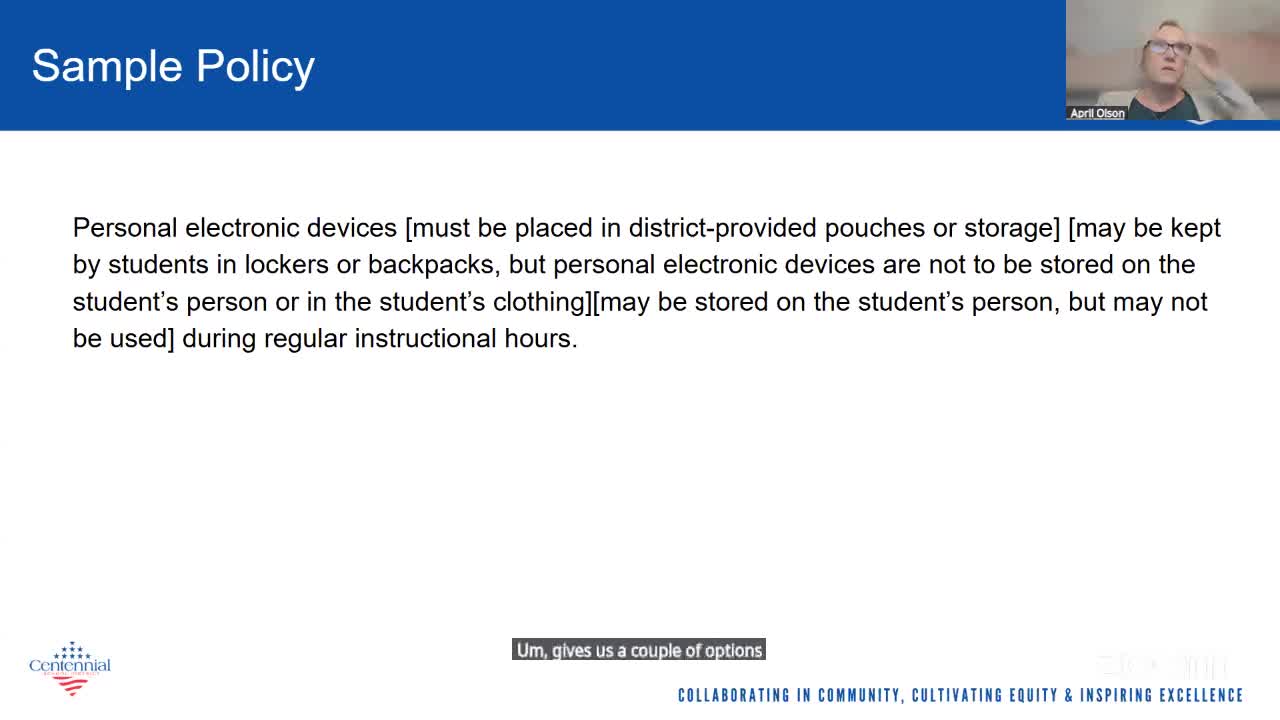School Board Evaluates Student Cell Phone Policy for Lockers and Personal Storage
September 24, 2025 | Centennial SD 28J, School Districts, Oregon
This article was created by AI summarizing key points discussed. AI makes mistakes, so for full details and context, please refer to the video of the full meeting. Please report any errors so we can fix them. Report an error »

In a recent board work session for the Centennial School District 28J, discussions centered around the management of personal electronic devices in schools, highlighting a range of opinions among board members. The meeting, held on September 24, 2025, revealed a divide on whether students should be allowed to keep their devices on their person during school hours.
The conversation began with a proposal to allow personal electronic devices to be stored in district-provided pouches or lockers, with the option for students to keep them in their backpacks. However, the consensus leaned towards a more restrictive approach, suggesting that devices should not be stored on students' persons during instructional hours. This recommendation aligns with practices already in place at some secondary schools within the district.
Board members expressed varied perspectives on the issue. Some, like Director Hardin, advocated for a strict policy that would initially keep devices out of sight, suggesting that trust could be built over time to allow for more leniency. Others, such as Director Lynn, argued against strict measures, fearing that they could lead to unintended consequences, including students finding ways to circumvent the rules.
Vice Chair Morin echoed concerns about temptation, suggesting that keeping devices completely away from students would prevent distractions. Meanwhile, Director Soloski pointed out the impracticality of using lockers in high schools due to limited passing time between classes, advocating for a policy that allows devices in backpacks or on students' persons.
The board also discussed the approach taken by the North Clackamas School District, which has implemented a more flexible policy based on grade level. This sparked interest among board members, who considered the potential benefits of tailoring policies to different age groups.
As the discussion progressed, Superintendent Owens noted that some schools within the district have successfully implemented policies allowing devices on students' persons without significant issues. However, concerns were raised about the lack of input from parents and students, with some board members feeling that decisions were being made prematurely without broader stakeholder engagement.
The meeting concluded with a call for further discussion on the definitions and implications of the proposed policy, emphasizing the need for a thoughtful approach to managing personal electronic devices in schools. As the board continues to navigate this complex issue, the balance between maintaining a conducive learning environment and accommodating students' needs remains a central focus.
The conversation began with a proposal to allow personal electronic devices to be stored in district-provided pouches or lockers, with the option for students to keep them in their backpacks. However, the consensus leaned towards a more restrictive approach, suggesting that devices should not be stored on students' persons during instructional hours. This recommendation aligns with practices already in place at some secondary schools within the district.
Board members expressed varied perspectives on the issue. Some, like Director Hardin, advocated for a strict policy that would initially keep devices out of sight, suggesting that trust could be built over time to allow for more leniency. Others, such as Director Lynn, argued against strict measures, fearing that they could lead to unintended consequences, including students finding ways to circumvent the rules.
Vice Chair Morin echoed concerns about temptation, suggesting that keeping devices completely away from students would prevent distractions. Meanwhile, Director Soloski pointed out the impracticality of using lockers in high schools due to limited passing time between classes, advocating for a policy that allows devices in backpacks or on students' persons.
The board also discussed the approach taken by the North Clackamas School District, which has implemented a more flexible policy based on grade level. This sparked interest among board members, who considered the potential benefits of tailoring policies to different age groups.
As the discussion progressed, Superintendent Owens noted that some schools within the district have successfully implemented policies allowing devices on students' persons without significant issues. However, concerns were raised about the lack of input from parents and students, with some board members feeling that decisions were being made prematurely without broader stakeholder engagement.
The meeting concluded with a call for further discussion on the definitions and implications of the proposed policy, emphasizing the need for a thoughtful approach to managing personal electronic devices in schools. As the board continues to navigate this complex issue, the balance between maintaining a conducive learning environment and accommodating students' needs remains a central focus.
View full meeting
This article is based on a recent meeting—watch the full video and explore the complete transcript for deeper insights into the discussion.
View full meeting
